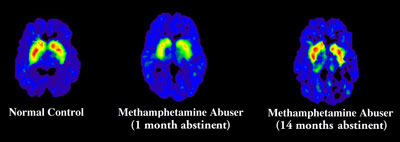Methamphetamine Abuse Linked to Impaired Cognitive and Motor Skills Despite Recovery of Dopamine Transporters
Download PDF Version What is PDF?
Patrick Zickler
Patrick Zickler is a Staff Writer for NIDA NOTES.
Source: NIDA NOTES, Vol. 17, No. 1, April, 2002
Public Domain
Table of Contents (TOC)
IntroductionChapter 1:Dopamine Transporter Damage After Brief Abstinence
Chapter 2:Dopamine Transporter Recovery
References
Animal studies have demonstrated that methamphetamine, a highly addictive stimulant, damages brain cells involved in transport of the chemical messenger dopamine. Now, NIDA-supported researchers have found that long-term methamphetamine abuse by humans is associated with a reduction in dopamine transporters after 2 months’ abstinence from methamphetamine and that this damage appears to be linked to slowed motor skills and weakened memory. Methamphetamine abusers who were retested after remaining abstinent for at least 9 months showed substantial recovery from damage to the dopamine transporters but not from impairments in motor skills and memory.
 Brain images of a person who has never used methamphetamine (left) and of a methamphetamine user after 1 month of abstinence (center).
Lighter colors show distribution of dopamine transporters (DAT) in the striatum. DAT distribution is reduced in striatum of methamphetamine user.
Brain image of a methamphetamine user after 14 months’ abstinence (right) shows substantial recovery of DAT in striatum. Low levels of DAT in
methamphetamine users were associated with poorer performance on tests of memory and motor skills, which did not improve with DAT after lengthy abstinence.
Brain images of a person who has never used methamphetamine (left) and of a methamphetamine user after 1 month of abstinence (center).
Lighter colors show distribution of dopamine transporters (DAT) in the striatum. DAT distribution is reduced in striatum of methamphetamine user.
Brain image of a methamphetamine user after 14 months’ abstinence (right) shows substantial recovery of DAT in striatum. Low levels of DAT in
methamphetamine users were associated with poorer performance on tests of memory and motor skills, which did not improve with DAT after lengthy abstinence.
Dr. Nora Volkow and colleagues at the Brookhaven National Laboratory in Upton, New York, and at the University of California, Los Angeles, used brain imaging studies and tests of motor skills and memory to investigate the effects of methamphetamine in 15 former methamphetamine abusers. The participants (nine women and six men, average age 32 years) had used the drug at least 5 days per week for at least 2 years, and had been abstinent from methamphetamine for at least 2 months.
The researchers used positron emission tomography (PET) to measure levels of dopamine transporters in the brain. PET imaging detects signals from chemical "tracers" that are injected into the bloodstream and carried to the brain, where they bind to dopamine transporters. The strength of the signals indicates the number of transporters. Compared with participants who never used the drug, methamphetamine abusers had an average reduction of 24 percent in levels of dopamine transporters (DAT) in the striatum, a part of the brain associated with control of movement, attention, motivation, and reward.
 Participants also took a series of tests to assess brain functions associated with the striatum: fine motor skills (inserting pegs into angled holes as quickly as possible),
gross motor skills (walking as rapidly as possible in a straight line), and memory (learning and recalling a list of unrelated words immediately, after a delay, and after a
distraction). "The abstinent methamphetamine abusers showed impaired memory and slowed motor skills that were directly proportional to the deficits in DAT. The lower the levels
of DAT, the worse their performance," Dr. Volkow says.
Participants also took a series of tests to assess brain functions associated with the striatum: fine motor skills (inserting pegs into angled holes as quickly as possible),
gross motor skills (walking as rapidly as possible in a straight line), and memory (learning and recalling a list of unrelated words immediately, after a delay, and after a
distraction). "The abstinent methamphetamine abusers showed impaired memory and slowed motor skills that were directly proportional to the deficits in DAT. The lower the levels
of DAT, the worse their performance," Dr. Volkow says.
"The reduction of dopamine transporters was seen in all of the abusers," Dr. Volkow says. "DAT loss also occurs with age at a rate of 6 to 7 percent per decade, so the DAT losses in methamphetamine abusers are roughly equivalent to 40 years of aging." Furthermore, she says, DAT reduction in the range of 40 to 90 percent is one characteristic of Parkinson’s disease, a progressive neurodegenerative disorder that causes tremor, weakness, and -- in some patients -- cognitive impairment. "There is a concern that methamphetamine abusers may be at increased risk for neurodegenerative disease as they age. This will depend in part on the reversibility of DAT losses induced by methamphetamine abuse."
To assess the persistence of methamphetamine-related DAT loss and impairments, the researchers reevaluated five study participants (three women and two men, average age 29 years) after they had abstained from taking the drug for at least 9 months. While these participants’ DAT levels had increased to roughly equal those of never-users of methamphetamine, they performed no better than before on tests of gross and fine motor skills and memory. Additional evaluations of five other former methamphetamine abusers with 9 months or more of abstinence (four women and one man, average age 35 years) produced similar findings: normal DAT levels but reduced motor and cognitive skills.

"This study documents significant recovery of DAT with protracted abstinence from methamphetamine," Dr. Volkow says. "Moreover, for those evaluated twice, the longer the interval between the first and second evaluations, the larger the increases in DAT. This suggests that recovery is related to the length of time that methamphetamine abusers can stay off the drug. But, although there is a recovery in DAT levels, there is no parallel improvement in function."
The relationship between impaired function and DAT loss and recovery is unclear. It is possible that the DAT recovery is due to increased branching of dopamine terminals rather than increased numbers of terminals, Dr. Volkow says. "This may be insufficient to compensate for lost terminals. It is also possible that the neuropsychological functions require other brain systems that recover slowly or not at all from the effects of methamphetamine. Or the failure to find an unambiguous association between DAT recovery and improved function might reflect the small number of participants who were able to stay drug free. We will need longer term studies to see if increases in DAT over longer periods of time are sufficient for complete recovery of function."
Volkow, N.D., et al. Association of dopamine transporter reduction with psychomotor impairment in methamphetamine abusers. American Journal of Psychiatry 158(3):377-382, 2001.
Volkow, N.D., et al. Loss of dopamine transporters in methamphetamine abusers recovers with protracted abstinence. Journal of Neuroscience 21(23):9414-9418, 2001.


